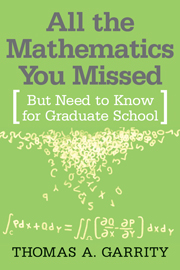Book contents
- Frontmatter
- Contents
- Preface
- On the Structure of Mathematics
- Brief Summaries of Topics
- 1 Linear Algebra
- 2 ∈ and δ Real Analysis
- 3 Calculus for Vector-Valued Functions
- 4 Point Set Topology
- 5 Classical Stokes' Theorems
- 6 Differential Forms and Stokes' Thm.
- 7 Curvature for Curves and Surfaces
- 8 Geometry
- 9 Complex Analysis
- 10 Countability and the Axiom of Choice
- 11 Algebra
- 12 Lebesgue Integration
- 13 Fourier Analysis
- 14 Differential Equations
- 15 Combinatorics and Probability
- 16 Algorithms
- A Equivalence Relations
- Bibliography
- Index
11 - Algebra
Published online by Cambridge University Press: 11 April 2011
- Frontmatter
- Contents
- Preface
- On the Structure of Mathematics
- Brief Summaries of Topics
- 1 Linear Algebra
- 2 ∈ and δ Real Analysis
- 3 Calculus for Vector-Valued Functions
- 4 Point Set Topology
- 5 Classical Stokes' Theorems
- 6 Differential Forms and Stokes' Thm.
- 7 Curvature for Curves and Surfaces
- 8 Geometry
- 9 Complex Analysis
- 10 Countability and the Axiom of Choice
- 11 Algebra
- 12 Lebesgue Integration
- 13 Fourier Analysis
- 14 Differential Equations
- 15 Combinatorics and Probability
- 16 Algorithms
- A Equivalence Relations
- Bibliography
- Index
Summary
Basic Objects: Groups and rings
Basic Maps: Group and ring homomorphisms
While current abstract algebra does indeed deserve the adjective abstract, it has both concrete historical roots and modern day applications. Central to undergraduate abstract algebra is the notion of a group, which is the algebraic interpretation of the geometric idea of symmetry. We can see something of the richness of groups in that there are three distinct areas that gave birth to the correct notion of an abstract group: attempts to find (more accurately, attempts to prove the inability to find) roots of polynomials, the study by chemists of the symmetries of crystals, and the application of symmetry principles to solve differential equations.
The inability to generalize the quadratic equation to polynomials of degree greater than or equal to five is at the heart of Galois Theory and involves the understanding of the symmetries of the roots of a polynomial. Symmetries of crystals involve properties of rotations in space. The use of group theory to understand the symmetries underlying a differential equation leads to Lie Theory. In all of these the idea and the applications of a group are critical.
- Type
- Chapter
- Information
- All the Mathematics You MissedBut Need to Know for Graduate School, pp. 213 - 230Publisher: Cambridge University PressPrint publication year: 2001

